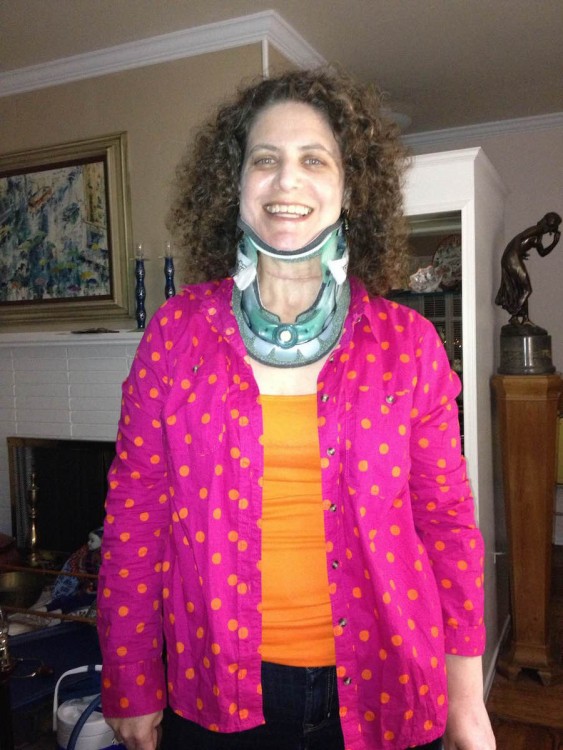Why I Choose Clothes That Make Me Look as If I'm Not in Pain
Most days I look much different from the way I feel. I can be in excruciating pain, but toss on the right outfit, and my love of cupcakes is not the only thing that’s hidden. (OK, sort of hidden.) Much of the time people who know about my condition comment that I look good, often with an air of shock.
That usually feels great. I mean, who wouldn’t want to hear that they look good? I welcome and appreciate those genuine comments. There are also times when hearing them is not such a thrill, and I want to toss a really big stack of medical journals at the person and say, “Read.”
To be clear about the whole “looking good” notion, I’m not referring to attractiveness by any standard. It’s about the significant conflict between how I present on the outside and the disheveled appearance of my central nervous system.
In our era of political correctness when language matters more than ever, I understand that some people may be thinking, Now it’s not even OK to tell somebody they look good?!
Sure it is, for me, anyway. I love a compliment as much as the next person. In my opinion, there’s really no need to stop. The difference to me is the energy behind the words — whether it’s an authentic verbal gift or a statement with subtext. For me it’s almost always the former, which feels so good. The pain shows on some days, so I’m pleased to hear about the times when my outside doesn’t look like my inside.
Sharing the experience that so many others in pain have, I interface with doctors, strangers and even friends who assume I’m physically well, based on my appearance rather than my reality. Some people are versed at saying, “You can’t possibly be in that much pain” without ever speaking those words. It would be nice to be oblivious to those unspoken (and sometimes spoken) judgements, but those of us in chronic pain have been through enough to recognize them. Fortunately, kind and loving people make these experiences marginal for me.
People see through their own personal field of vision, so when it comes to my outside appearance, I try not to make it about anybody else. What matters is how I choose to take care of myself in order to get through an hour at home or enjoy an event when it feels like my nerves are surrounded by hot coals. Much of the time I “look as if.” As if I’m comfortable in my seat. As if I don’t feel electric shocks going through my limbs. As if my hands aren’t freezing in a warm setting. As if I wasn’t in the emergency room yesterday. As if getting dressed that morning didn’t hurt. As if the pain didn’t wake me up every couple of hours the night before. As if I don’t need my cane, poles or wheelchair. I usually dress as if I have a future with less pain, and it’s one of many things I do to help me maintain hope that it’s true.
After I had to stop working, I missed the feeling of putting on clothes each morning that communicated I’m a professional. When I was facing a long recovery from my second multi-level spine surgery, I wanted to approach the days in something other than sweats and leggings. They’re great on occasion (and necessary sometimes), but I was determined not to wear them more than a couple times per week. Any more than that, I decided they would make a statement I wasn’t interested in hearing.

So, what to wear? I love a sleek black outfit that gives me the illusion of being fashionable. My closet has always offered me plenty of options for the city look. But as my pain increased, I shifted my wardrobe. I began to frequent budget-friendly stores for clothes that were easier to to put on, like those with zippers and snaps. My range of colors started to expand too. I bought colorful jeans and shirts including bright blue, purple and an array of pinks. Some orange even entered my closet, which I later learned was convenient to my medical situation. It’s the color to promote complex regional pain syndrome (CRPS) awareness. My loyalty to the San Francisco Giants grew as well. Go figure.
Colorful clothing helps to keep me from looking the way I feel to some extent, but pain can show in the eyes. Fortunately, all of the good things in life do as well. There are days when the latter creates a glow that reads, “I have no worries, just a joyful existence.” There are definitely those other days when I look in the mirror and see eyes dark and filled with struggle, and I barely recognize myself, even after all the years of being in pain. My joie de vivre gets masked, unlike when pain is overshadowed by the rest of my life; all the things that are a blessing. So I go with it and tell myself it’s where I am today.
Off to my dresser to pull out those ultra-comfortable leggings that highlight the massive swelling in my leg, paired with the coziest old shirt I have clean. I hope tomorrow I toss on something colorful that speaks to my love of life, but for today, this is my ensemble of self-care.
Follow this journey on Elisa Friedlander.
The Mighty is asking the following: What’s one unexpected source of comfort when it comes to your (or a loved one’s) disability and/or disease? If you’d like to participate, please send a blog post to community@themighty.com. Please include a photo for the piece, a photo of yourself and 1-2 sentence bio. Check out our Submit a Story page for more about our submission guidelines.
